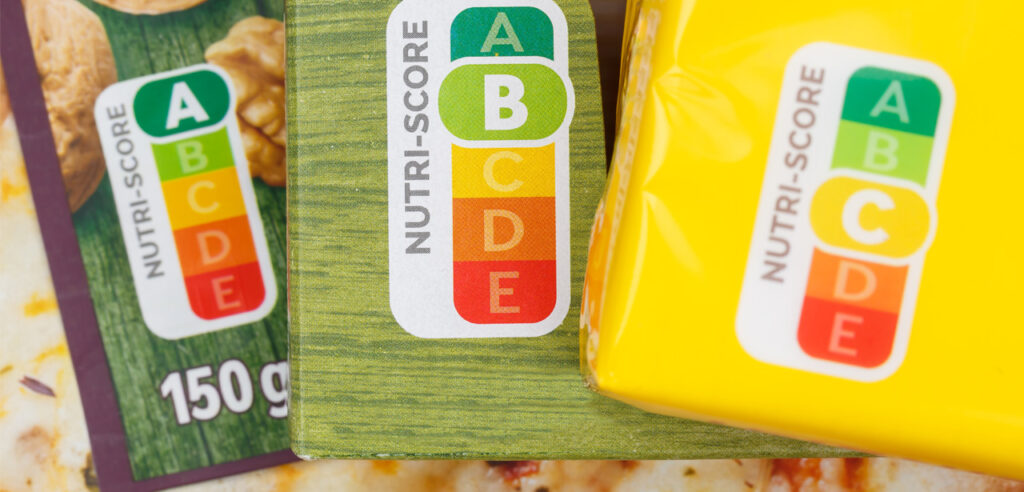The grocery store can be an overwhelming landscape. With countless products vying for attention, how does one decide which brand or product to choose?
For health-conscious consumers, Nutri-Score presents a potential solution. This food ranking system, prominently displayed on packaging, aims to guide people toward healthier food choices.
Nutri-Score is a nutrition labelling system created in France in 2017 and subsequently adopted by several European countries. The system assigns food and beverage items a score from A to E, with A representing the healthiest option and E the least nutritious. This scoring is based on key ingredients such as sugar, salt, and fiber. Further, the color-coded letter scale enables consumers to quickly identify the most recommended foods. Developed to simplify nutritional information, Nutri-Score helps consumers make more informed purchasing decisions.

Seen and Trusted: But Do We Truly Understand It?
The French public largely knows and trusts the system.
According to Santé Publique France, an impressive 64% of French consumers now select products based on their Nutri-Score. Since its introduction, the system has been widely recognised as a crucial public health tool, particularly in combating obesity and diet-related diseases. Research demonstrates that Nutri-Score significantly influences consumer food choices.
Arthur, a doctor who cyclised to work daily, explains: “It definitely influences my product purchases, perhaps even subconsciously. For brands I know well, I’ll buy automatically without exploring alternatives. But with products where I have no brand loyalty, I’ll deliberately choose the healthiest option.”
The critical question remains: Do we actually understand the science behind that letter?
Camille, an active university professor, who also follows a pescatarian diet, candidly shares: “I always check the score—it’s right there at the front, impossible to miss. I believe everyone looks at it. But honestly, I don’t understand why a particular product receives a specific letter. I’m unsure about their calculation method. However, I assume scientists were involved, so I trust it’s reliable.”

The Algorithm
Nutri-Score provides a simplified assessment of a food product’s nutritional quality by evaluating several key nutritional composition elements.
The includes three main categories of products:
- General foods
- Specific rule for Cheeses
- Specific rule for Red meat
- Animal and vegetable fats, nuts and seeds
- Beverages
The nutritional score for food products relies on the calculation of a single, overall score which takes into account, for every food product:
– a “negative” component N
– a “positive” component P
The N component of the score takes into account nutritional elements which consumption should be limited: energy, saturated fatty acids, sugars, and sodium. For each of these elements points from 0 to 10 are awarded based on the content for 100 g of food product (see. Table 1). The negative N component corresponds to the sum of these points and thus can range from 0 to 40.

The P component is calculated based on the amount of fibres, proteins, and fruits, vegetables, legumes, nuts as well as rapeseed, walnut and olive oils in the food product. For each of these elements, points from 0 to 5 are awarded based on the content for 100 g of food product (see Table 2). The positive P component corresponds to the sum of these points and thus can range from 0 to 15.

The final nutritional score for a food is found by subtracting the total number of favourable points from the total number of unfavourable points. In addition, the level of unfavourable points can cause the favourable points to vary depending on whether points for protein are counted.
Depending on the score obtained for the N component, the final nutritional score is calculated as follow:
- If the total of component N is below 11 points or if the product is cheese, then the nutritional score is equal to the total N component points from which is subtracted the total for the P component.
Nutritional score = total N points – total P points
- If the total of the N component is greater than or equal to 11 points, then the nutritional score is equal to the total N component points from which is subtracted the sum of the points for “fibres” and “fruits, vegetables, legumes”. In this case, the protein content is therefore not taken into account in the calculation of the nutritional score.
Nutritional score = total N points – “fibres” points – “fruits, vegetables, legumes” points
Something Not to Trust
Despite its innovative approach, the Nutri-Score system is not without significant flaws. One of the most critical criticisms is the oversimplified approach to sugar content. The current algorithm fails to distinguish between added sugars and naturally occurring sugars, a nuance that can lead to misleading nutritional assessments.
A prime example of this shortcoming is the scoring of fruit juices. Under the current system, these beverages can receive nearly the same score as whole fresh fruits, despite substantial differences in nutritional value. Fresh fruits contain naturally occurring sugars accompanied by fiber, vitamins, and other essential nutrients. In contrast, fruit juices often strip away these beneficial components, leaving behind concentrated sugar with minimal nutritional benefits.
This limitation means consumers can be misled about the true nutritional value of products. A fruit juice might appear almost as healthy as whole fruit based on the Nutri-Score, when in reality, it represents a significantly less nutritious option. Such oversimplification undermines the very purpose of the scoring system—to provide clear, accurate nutritional guidance.
Nutritional experts argue that a more nuanced approach is necessary. The algorithm should differentiate between intrinsic sugars found naturally in whole foods and added sugars that contribute little to nutritional value. Until such distinctions are made, Nutri-Score risks providing consumers with a false sense of nutritional understanding.

2024 Updates
The algorithm calculating food scores has recently been refined to more accurately reflect nutritional information.
Pauline Ducrot, a prevention and health promotion expert at Santé Publique France, explains: “The core elements remain consistent, but we’ve revised calculation rules to enable more precise product comparisons.”
A broader range of products is now included in the system. “For beverages,” she adds, “we now factor in sweeteners to prevent manufacturers from using additives to artificially improve their rating. Light sodas with sweeteners will now be rated C to E, instead of B.”
An official review of the updated 2024 algorithm is set to be completed by the end of the year.



Lascia un commento